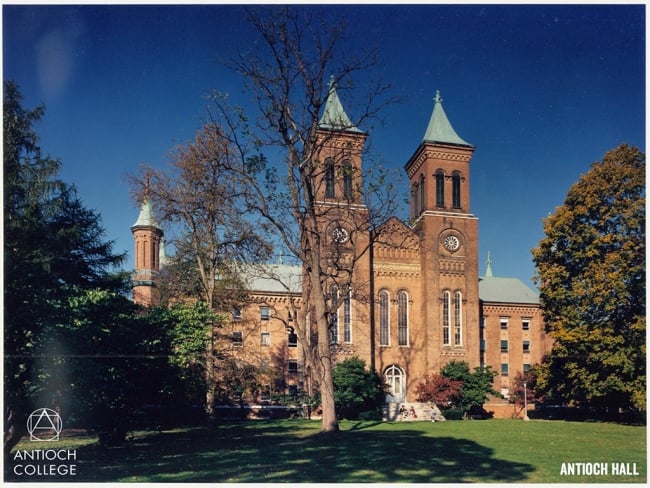You have /5 articles left.
Sign up for a free account or log in.

Antioch College
Some faculty members have grown increasingly unsettled about Antioch College’s future, worrying the small private liberal arts college in western Ohio is trailing enrollment goals for its upcoming fall quarter even as it comes off a period of furloughs and pay cuts.
College officials on Thursday disputed an anonymous tip that Antioch currently has 34 new students signed up for its Class of 2022, significantly trailing a goal of 75 that was made public earlier this year. Antioch is focused instead on enrolling the right mix of students to hit a new revenue target, they said. But they did not share any alternative new student enrollment snapshot Thursday, saying only that the college is on track for a significant increase over last year.
Last year, 28 new students came to campus against a goal of 60 for the fall of 2017. If Antioch were to miss an enrollment target again, it could increase pressure on a college that has been heavily dependent on donations since it reopened in the fall of 2011. Antioch offered full-tuition scholarships for several years after it reopened as it re-established its accreditation, but it has since struggled to transition to charging tuition. Consequently, its enrollment and budget figures draw scrutiny as those within the college and across higher education watch to see if students are willing to pay -- and if a once-closed college can stabilize its financial model.
This week, an anonymous faculty member emailed Inside Higher Ed, saying that Antioch’s Class of 2022 currently stands at 34 students, less than half of a goal of 75 that was published in February. The email included details about a letter faculty members sent to college leaders voicing displeasure after Antioch announced cuts in March to address a budget deficit, and it included a response from the college’s board. The letter also expressed concern about faculty members leaving the college.
One Antioch faculty member speaking on background confirmed the enrollment number of 34 new students, saying it is well-known on campus. The faculty member also confirmed that several tenure-track faculty members are soon leaving the college.
The number of new students enrolling may look low, but it has sparked optimism in some corners because it is better than where Antioch was at a comparable point last year, the faculty member continued. Weeks before the start of its 2017 fall quarter, the college had signed up 22 new students.
But college officials disputed the tip’s accuracy. Christine Reedy, communications specialist, said in an email that the number was not correct but that she might not be able to gather additional information until early next week. Gariot P. Louima, dean of admission and external relations, also said the number was off.
“The fall 2018 cycle is still open for us as we have rolling admission,” Louima said in an email. “Our committee meets weekly to review applications. As I have recently submitted applications and recently admitted students in this cycle, I wouldn't feel comfortable releasing a number that will be inaccurate upon publication. We do, however, expect increases in net revenue and new matriculates this fall.”
Neither Reedy nor Louima responded to follow-up requests seeking additional information on how many new students were enrolled for the fall. Tom Manley, Antioch’s president, was vacationing and did not have the latest numbers available Thursday.
The number of new students for the fall reported by the faculty member who sent the email tip "could have been a real number two weeks ago," Manley said in a phone interview. It could be different today, and today's number is not where Antioch plans on landing.
"You take a snapshot and you have students and their applications that you're still processing, and the probable numbers that you're going to convert," he said. "So if you look at a number right now, on July 5, that's not necessarily the number that you're going to have on Sept. 1."
Antioch is attempting to get away from the practice of presenting an enrollment number for today and a goal for the future, Manley said. It hasn't served the college in the past, and distracts from the results the college needs and is getting.
"We have completely redesigned the curriculum," Manley said. "We have developed a new calendar. We have a clear value proposition offering. We have developed an experiential focus … and so I am very optimistic."
Manley acknowledged that it's not unrealistic to worry about any college's future in the year 2018. Antioch is trying to disrupt higher education in a disruptive time. While it may be challenging work, people on Antioch's board, in its faculty and in its community are excited about its direction, he said.
"Before I left, I looked at some projections in terms of cash for the next quarter or two, and we look good, or we're OK," Manley said.
At the very least, the situation is a reminder to watch Antioch College, which reopened as an independent institution in 2011 after Antioch University -- which operates campuses with graduate and professional programs at locations around the country and online -- decided in 2007 to close it amid enrollment and financial struggles. In addition to changing its tuition model since then, the college has gone through several rounds of cost cutting. Most recently, it announced cuts effective between March and June of this year. Staff earning more than $40,000 annually needed to take 10 days of unpaid leave by the end of June, and faculty members had their salaries reduced by 11 percent over the same period.
In response to those cuts, faculty members drafted a March 12 letter expressing dismay. They also voiced concern about a lack of funding for faculty development, faculty retention issues and levels of representation on a planning and finance committee.
Several weeks later, Board of Trustees chair Barbara Winslow responded with a letter to faculty expressing regret for the salary reductions and furloughs and addressing several other concerns. The board is doing everything it can to support the college’s move toward financial stability, the letter said.
“We have unanimously and strongly endorsed the President's Action Areas and the financial model proposed by the President and the Finance and Planning Committee,” it said. “We ask you to give it your full support as it is introduced and developed beginning next quarter and over the next 3-5 years. We also encourage you to work collaboratively with the Provost to bring the full power and creativity of the faculty to these efforts and to translate your concerns into practical solutions and opportunities.”
After the furloughs and salary cuts were announced, Antioch’s president, Manley, told The Yellow Springs News that the college had made progress reducing expenses. But it hadn’t held expenses to the budget trustees had set, prompting the need for additional cuts.
The planned cuts did not entirely eliminate the budget shortfall. It’s not clear whether Antioch closed the year at the end of June with a deficit -- it is too soon after the end of the fiscal year for the calculations to be finished, Manley said.
Antioch lost a reported $1.7 million for the year ending June 30, 2017, a year in which its expenses totaled $17.6 million. That was down from a $7 million deficit the previous year. The college employed 118 staff members and 31 faculty members as of January, not counting adjuncts.
Asked whether Antioch would have had enough cash to make payroll if the furloughs and salary cuts weren't put in place, Manley responded that the savings from the moves were significant. The college was also able to raise additional money. Today, no furloughs are in place, the salary cuts are no longer in place, and professional development has been returned to the budget.
"It would have been touch and go, yeah," he said about cash levels without the cuts last year. "In the end, it was about the board saying … we want to make sure the college gets closer to budget. So I don't think it was a hollow exercise by any means."
Manley has previously discussed many of the strategic issues at play. In a telephone interview with Inside Higher Ed in September 2017, he talked about Antioch’s changing value proposition. When Antioch was offering full scholarships, many families were choosing the college because they understood the value proposition of a free college education. As leaders worked to end free tuition, the value proposition that remained wasn’t what leaders necessarily thought it was.
“What we’re looking to do is shape a value proposition, a clear value proposition, which, frankly, Antioch didn’t have in the first period of its start-up phase when it was trying to get accreditation,” Manley said. “Very much our value proposition was, ‘We’re a liberal arts college that has an emphasis on social justice and history of cooperative education and a long legacy of doing these things, and that’s why you should join us.’”
Affordability would remain a critical piece of Antioch’s new value proposition, Manley said. He also said the college would be paying attention to demographics, starting locally in its region and in Ohio while also looking to other parts of the country. It would look where students are attracted by autonomy, agency and making an impact in areas like the environment, democracy, social justice and creativity.
Manley used the language of a business start-up several times during the September interview. He referred to Antioch’s alumni as angel investors.
The college was raising $12 million per year, mostly for operations. Alumni were giving to support Antioch’s efforts to reinvent the model of a small-college education, he said.
That would mean donations make up a remarkably large chunk of Antioch’s operating revenue, reported at $15.9 million for the fiscal year ending in 2017. But Manley did not seem worried about donor fatigue.
“I can’t say by year 2020, if we’re not there, we’re done,” he said of budget goals. “This college and the alumni fought too hard to gain its independence. They’re going to do whatever is necessary to keep going forward.”
Not every faculty member was concerned for Antioch. One speaking on background expressed growing bullishness for the college. Another said many faculty members feel confident in its new admission dean, Louima.
A third, who was willing to speak on the record Thursday, acknowledged Antioch’s struggles but expressed optimism for the future. Corine Tachtiris is an assistant professor of non-Western literature who is a member of the Executive Committee of the Faculty.
“Antioch has faced a lot of challenges over the last year,” Tachtiris said. “And those challenges will continue to pose problems over the next year, and possibly years. But I still believe that Antioch can ride out the rough waves.”




